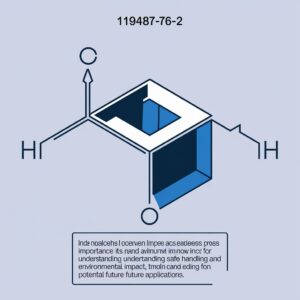119487-76-2 is a key chemical compound with the molecular formula C8H8O, recognized for its diverse applications across various industries. Commonly used as an intermediate in the synthesis of pharmaceuticals, agrochemicals, and dyes, this compound plays a crucial role in developing new materials and products. Its unique structure, featuring a phenolic group, enables it to serve as a versatile building block in chemical manufacturing. Understanding its properties and safe handling practices is essential for researchers and manufacturers. As innovations continue, 119487-76-2 is poised to contribute significantly to advancements in science and technology.
What is 119487-76-2?
The chemical compound known as 119487-76-2 is identified by its unique CAS (Chemical Abstracts Service) number. CAS numbers are numerical identifiers that give a unique identity to every chemical substance, including compounds, alloys, mixtures, and polymers. These identifiers are used worldwide for chemical substances to standardize nomenclature and facilitate communication among researchers, manufacturers, and regulators.
Chemical Structure and Properties of 119487-76-2
119487-76-2 is a chemical compound with the molecular formula C8H8O. The structure includes eight carbon (C) atoms, eight hydrogen (H) atoms, and one oxygen (O) atom. The compound falls into the category of organic compounds, specifically those containing a phenol group, which is characterized by a hydroxyl group (-OH) bonded directly to an aromatic hydrocarbon group.
Chemical Structure:
- Molecular Formula: C8H8O
- InChI: InChI=1S/C8H8O/c1-5-4-6-2-3-7(9)8(5)6/h2-3,6,9H,1H3
- SMILES: CC1=CC=C(C=C1)O
Uses and Applications of 119487-76-2
The compound 119487-76-2 is primarily used in the field of chemical research and development. It serves as an intermediate in the synthesis of various organic compounds. Its structure, which includes a hydroxyl group attached to an aromatic ring, makes it versatile for use in several applications:
Pharmaceuticals:
The compound is often used in the synthesis of drugs, particularly those involving phenolic structures. Phenolic compounds are known for their antioxidant properties and potential health benefits, including anti-inflammatory and anti-cancer effects.
Agrochemicals:
In agriculture, 119487-76-2 may be used to create herbicides or pesticides that protect crops from pests and diseases. Its role as an intermediate allows for the development of more complex molecules that can be used to enhance crop yield and reduce losses.
Dyes and Pigments:
The compound is also used in the manufacture of dyes and pigments. Its chemical structure allows for the development of substances that can provide vibrant colors when used in various materials.
Plastics and Polymers:
It serves as a precursor in the production of certain polymers and plastics, contributing to materials that have specific desirable properties, such as flexibility, durability, or resistance to chemicals.
Safety and Handling of 119487-76-2
Handling chemicals like 119487-76-2 requires caution due to potential hazards. Here are some safety guidelines:
- Personal Protective Equipment (PPE): Always wear appropriate PPE, including gloves, goggles, and lab coats, when handling the compound to prevent direct contact with skin or eyes.
- Ventilation: Use in a well-ventilated area to avoid inhalation of fumes. If available, a fume hood is ideal for conducting experiments with chemicals that can produce harmful vapors.
- Storage: Store the chemical in a cool, dry place away from incompatible substances such as strong oxidizers, acids, or bases, which could cause a hazardous reaction.
- Disposal: Follow local regulations for the disposal of chemical substances. Do not dispose of 119487-76-2 in regular trash or down the drain.
Environmental Impact of 119487-76-2
Understanding the environmental impact of chemicals like 119487-76-2 is crucial for sustainable practices. The compound, due to its phenolic structure, may pose risks if released into the environment in large quantities:
- Water Contamination: Phenolic compounds can contaminate water sources, posing risks to aquatic life. They are known to be toxic to fish and other aquatic organisms.
- Soil Pollution: If disposed of improperly, 119487-76-2 can contaminate soil, affecting plant growth and potentially entering the food chain.
- Air Quality: When burned or improperly disposed of, chemicals containing phenol groups can release harmful vapors that contribute to air pollution and respiratory issues in humans.
Regulatory Aspects of 119487-76-2
Due to its potential hazards, the use and handling of 119487-76-2 are regulated by various government agencies. These regulations ensure that the compound is used safely and responsibly to minimize risk to humans and the environment.
- OSHA: In the United States, the Occupational Safety and Health Administration (OSHA) provides guidelines for safe handling and exposure limits for various chemicals, including 119487-76-2.
- EPA: The Environmental Protection Agency (EPA) monitors the environmental impact of chemical substances. It may set limits on the amount of 119487-76-2 that can be released into the environment.
- FDA: If 119487-76-2 is used in the production of pharmaceuticals, the Food and Drug Administration (FDA) regulates its use to ensure the safety and efficacy of the final product.
Advanced Applications and Future Research
The use of 119487-76-2 extends beyond its current applications in pharmaceuticals, agriculture, and materials science. Ongoing research is exploring new ways to utilize this versatile compound:
Nanotechnology:
Scientists are investigating the potential of 119487-76-2 in the synthesis of nanoparticles. These nanoparticles could be used in targeted drug delivery systems, where they deliver drugs directly to specific cells or tissues, reducing side effects and improving efficacy.
Biodegradable Polymers:
Research is also being conducted on the use of 119487-76-2 to create biodegradable polymers. These materials could replace traditional plastics, reducing environmental impact and contributing to sustainability efforts.
Antioxidant Development:
Due to its phenolic structure, 119487-76-2 is being studied for its antioxidant properties. Antioxidants are important for protecting cells from damage caused by free radicals, and new antioxidants could have applications in medicine and skincare.
Insights and Analysis on the Use of 119487-76-2
119487-76-2 is more than just a chemical compound; it is a valuable tool in multiple industries, with its uses continually expanding as new research emerges. Here are some insights on its impact:
- Innovation Driver: The versatility of 119487-76-2 as an intermediate compound makes it an important player in the development of new technologies and materials. Its ability to be transformed into a variety of products highlights its importance in innovation.
- Sustainability Potential: As research into biodegradable materials and sustainable chemicals grows, 119487-76-2 could play a crucial role in creating greener alternatives to traditional materials.
- Health Implications: The potential use of 119487-76-2 in pharmaceuticals underscores the importance of chemical compounds in improving human health. Whether it’s in creating new drugs or delivering them more effectively, this compound could have significant health benefits.
FAQs
1 – What is 119487-76-2?
119487-76-2 is a chemical compound with the molecular formula C8H8O, primarily used as an intermediate in chemical synthesis for pharmaceuticals, agrochemicals, dyes, and plastics.
2 – What are the primary uses of 119487-76-2?
It is used in pharmaceuticals, agrochemicals, dyes and pigments, and as a precursor in the production of plastics and polymers.
3 – Is 119487-76-2 safe to handle?
When handled properly with appropriate safety measures such as PPE, ventilation, and proper storage, it is safe to use. However, like all chemicals, it should be handled with care.
4 – How should 119487-76-2 be stored?
It should be stored in a cool, dry place away from incompatible substances and in a well-ventilated area to prevent any hazardous reactions.
5 – What are the environmental risks of 119487-76-2?
It can pose risks such as water contamination, soil pollution, and air quality degradation if not handled and disposed of properly.
Conclusion
119487-76-2 is a multifaceted chemical compound with significant importance across various industries. From pharmaceuticals and agriculture to materials science and nanotechnology, its versatility and utility are apparent. Understanding the safe handling, environmental impact, and potential future applications of 119487-76-2 is crucial for professionals in the chemical industry, researchers, and policymakers. As research continues to unveil new uses and benefits of this compound, its role in innovation and sustainability will likely expand, contributing to advancements in technology and environmental stewardship.




